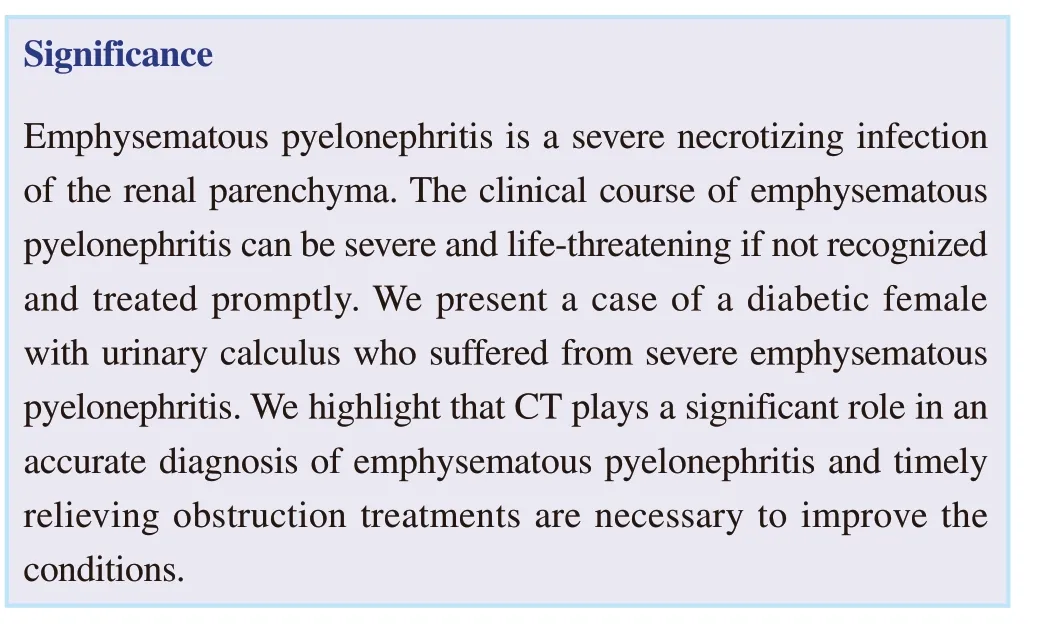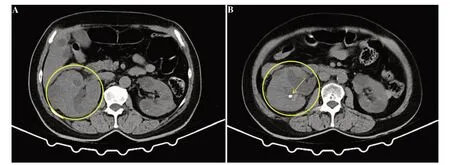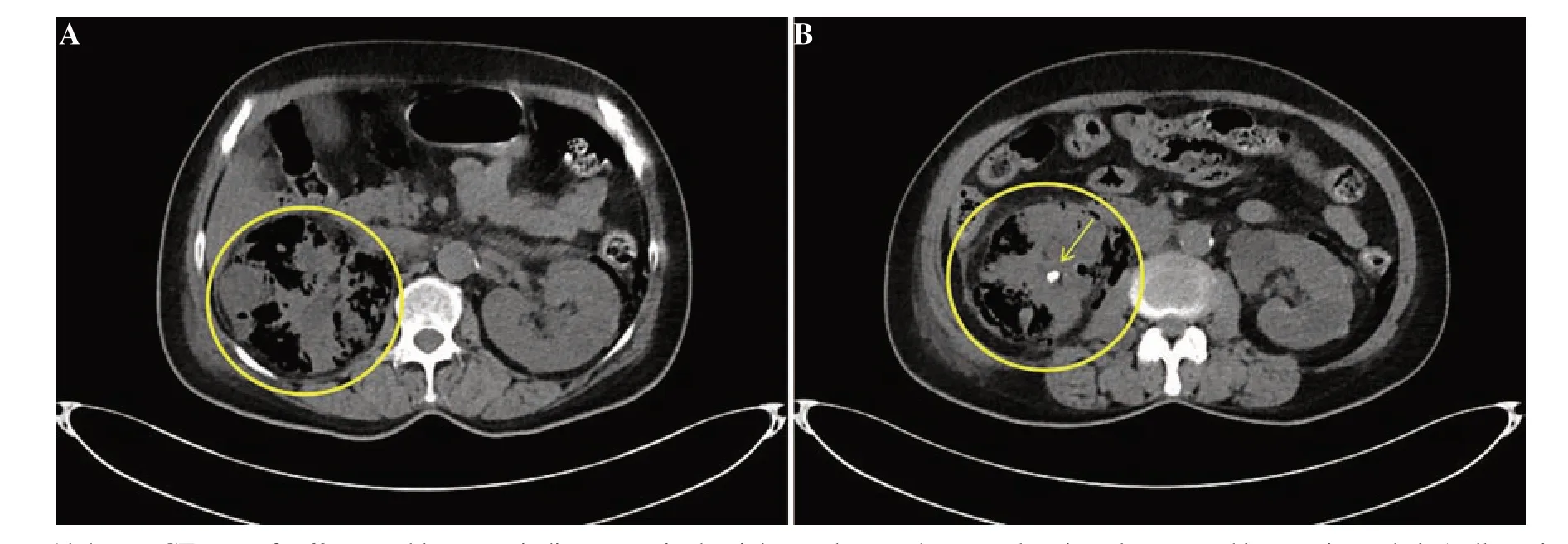An alveolate kidney: A case report of emphysema pyelonephritis
De-Gang Wang, Jian-Jiao Chen
1Department of Emergency Surgery, Chaoyang Municipal Central Hospital, Liaoning Province, China
2Department of General Surgery, Sun Yat-sen Memorial Hospital, Sun Yat-sen University, Guangzhou, China
ABSTRACT Rationale: Emphysematous pyelonephritis is a life-threatening infectious disease that requires early diagnosis and treatment.The disease is often misdiagnosed due to its diversity of clinical manifestations.Patient’s concern: A 62-year-old woman was admitted to the emergency department following a 12-hour history of abdominal pain and dyspnea.Physical examination showed percussion pain on the right costovertebral angle.Besides, she had a history of diabetes mellitus and urinary calculus.Diagnosis: Emphysematous pyelonephritis.Intervention: The patient accepted antishock therapy, tight glucose control, and broad-spectrum anti-infective therapy.After stabilization of the general condition, an ultrasound-guided percutaneous nephrostomy was performed.Outcome: Her conditions became stable over the following days.She presented a favorable clinical course, with normalization of renal function and positive improvements in imaging findings in a month.Lessons: Early diagnosis and rapid medical management are the keys to successful treatment.CT is an important method for the diagnosis of emphysematous pyelonephritis.For patients with severe lesions, percutaneous renal drainage combined with active anti-infection should be given in time.
KEYWORDS: Emphysematous pyelonephritis; CT; Conservative management
1.Introduction
Emphysematous pyelonephritis (EPN) is a renal gangrenous infection characterized by a large amount of gas presenting within the kidney and perirenal spaces.It is a serious illness that could be life-threatening[1].It has been closely associated with poorly controlled blood glucose levels and urinary tract obstruction.Accurate diagnosis and timely treatment are of extreme importance to avoid adverse outcomes.The best time of surgical treatment for EPN remains controversial.Increasing reports support the view that early percutaneous drainage may be crucial to protecting renal function.
2.Case report

This study was approved by the Ethical Committee of Chaoyang Municipal Central Hospital, and informed consent has been obtained from the patient.
A 58-year-old diabetic female was admitted to the emergency department following a 2-hour history of abdominal pain and nausea.She was diagnosed with urinary calculus and hydronephrosis at the urologic surgery clinic two days ago (Figure 1).
Physical examination revealed percussion pain on the right costovertebral angle and negative abdominal signs.Laboratory results revealed a leukocytosis of 10.02×109/L (normal range: 3.5-9.5×109/L)with 88.54% neutrophils (normal range: 50%-70%), CRP>10 mg/L (normal range: 0-3 mg/L), and PCT level of 29.18 ng/mL (normal range: 0-0.5 ng/mL).Her serum creatinine and urea nitrogens were 328.00 μmol/L (normal range: 44.2-132.6 μmol/L) and 39.88 mmol/L (normal range: 3.1-7.2 mmol/L), respectively.She has hyperglycemia with a blood glucose concentration of 25.47 mmol/L(normal range: 3.9-6.2 mmol/L).Abdomen CT scan indicated severe right hydronephrosis with a large volume of free air in the right kidney and perirenal space, and stones in the right ureter (Figure 2).

Figure 1.Abdomen CT scan of a 62-year-old woman shows a diffusely swollen right kidney (yellow circle) (A) and urolithiasis (yellow arrow) (B).

Figure 2.Abdomen CT scan of a 62-year-old woman indicates gas in the right renal parenchyme and perirenal space and intraperitoneal air (yellow circle) (A), and stones in the right ureter (yellow arrow) (B).
Based on the above findings, a diagnosis of EPN was made.The patient was treated with antishock therapy, glycemic control, and broad-spectrum anti-infective therapy.After stabilization of the general condition, ultrasound-guided percutaneous drainage was performed for her.
Her conditions became clinically stable over the following days.The cultures of blood and urine yielded Escherichia coli.She presented a favorable clinical course, with normalization of renal function and positive improvements in imaging findings.
3.Discussion
EPN is an acute, necrotizing infectious renal disease characterized by the presence of air within renal parenchyma and perirenal tissue.It is a life-threatening condition and should be promptly treated.In EPN morbidity hazard factors, what is dominant in the risk factors are hyperglycemia, bacterial infection, and urinary tract obstruction[2].In patients with poorly controlled blood glucose concentrations, the hyperglycemic environment under urinary tract obstruction provides ideal gas production conditions for microorganisms[3].
Fever and flank pain is most characteristic for EPN.Severe EPN may elicit septic shock which is associated with a high mortality rate.CT scan is now considered to be one of the most effective diagnostic tools for EPN, which may display the density, morphology, renal changes, renal parenchyma, and renal parenchyma of the lesions.The CT manifestations of EPN showed a “pineapple sign”, gas generated by bacteria may enter the abdominal cavity through the renal fatty membrane.According to CT findings, investigators suggested 4 classes of EPN and intended to provide appropriate treatment based on CT classification and clinical risk factors: Class 1, where gas is limited only to the renal collecting system; Class 2, where gas is confined within the renal parenchyma; Class 3A, where gas or an abscess diffuse to the perinephric space; Class 3B, where gas or the abscess spreads to the pararenal space; and Class 4, depicting a bilateral or solitary kidney with EPN[4].For classes 1 and 2, EPN patients may reach favorable clinical outcomes with conservative treatment or percutaneous drainage.For class 3 patients with lower risk, incision and drainage can be tried to relieve the obstruction, and nephrectomy should be performed for patients with ineffective drainage; for class 3 patients with 2 risk factors, immediate nephrectomy is the best choice; for class 4 patients, drainage should be tried first to maintain kidney function, and nephrectomy shall be ready at any time[5].
Accurate diagnosis and appropriate treatment for EPN are very important.As gram-negative bacteria are the most common pathogenic bacterium, before the results of microbiological culture are available, antibiotics target gram-negative bacteria should be rendered.Currently, once the diagnosis of EPN is made, the initial management includes antibiotics along with percutaneous drainage[6].Sufficient drainage may preserve renal function[7].When percutaneous drainage becomes invalid, open drainage surgery or emergent nephrectomy should be considered as an alternative solution if the condition continues to deteriorate.We present a rare case of EPN that is life-threatening, as CT showed free air not only spread around the right renal parenchyma but also extended outside the capsule.Owing to CT findings along with clinical history, an accurate diagnosis of EPN was made, subsequent early anti-infection treatment and percutaneous drainage contributed to her favorable clinical outcome.
Conflict of interest statement
The authors report no conflict of interest.
Authors’ contributions
D.G.W.: Clinical management, data acquisition, and analysis; J.J.C.: Literature search, data analysis, manuscript preparation, editing, and review.
 Journal of Acute Disease2022年2期
Journal of Acute Disease2022年2期
- Journal of Acute Disease的其它文章
- Electrocardiographic abnormalities in prevalent infections in tropical regions: A scoping review
- Goal-directed fluid therapy in gastrointestinal cancer surgery: A prospective randomized study
- Comparative study on effects of dexmedetomidine and dexamethasone on the incidence of postoperative nausea and vomiting in patients undergoing laparoscopic surgery
- Effect of cold weather on carotid artery stenosis and occlusion: A retrospective observational study
- Body mass index and COVID-19 outcomes: A retrospective crosssectional study at a tertiary care center in India
- Mortality characteristics during the two waves of COVID-19 in India: A retrospective observational study
